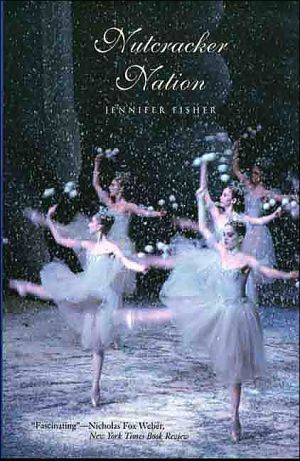Nutcracker Nation: How an Old World Ballet Became a Christmas Tradition in the New World
The Nutcracker is the most popular ballet in the world, adopted and adapted by hundreds of communities across the United States and Canada every Christmas season. In this entertainingly informative book, Jennifer Fisher offers new insights into the Nutcracker phenomenon, examining it as a dance scholar and critic, a former participant, an observer of popular culture, and an interviewer of those who dance, present, and watch the beloved ballet.\ Fisher traces The Nutcracker’s history from its...
Search in google:
The Nutcracker is the most popular ballet in the world, adopted and adapted by hundreds of communities across the United States and Canada every Christmas season. In this entertainingly informative book, Jennifer Fisher offers new insights into the Nutcracker phenomenon, examining it as a dance scholar and critic, a former participant, an observer of popular culture, and an interviewer of those who dance, present, and watch the beloved ballet.Fisher traces The Nutcracker’s history from its St. Petersburg premiere in 1892 through its emigration to North America in the mid-twentieth century to the many productions of recent years. She notes that after it was choreographed by another Russian immigrant to the New World, George Balanchine, the ballet began to thrive and variegate: Hawaiians added hula, Canadians added hockey, Mark Morris set it in the swinging sixties, and Donald Byrd placed it in Harlem. The dance world underestimates The Nutcracker at its peril, Fisher suggests, because the ballet is one of its most powerfully resonant traditions. After starting life as a Russian ballet based on a German tale about a little girl’s imagination, The Nutcracker has become a way for Americans to tell a story about their communal values and themselves. The Washington Post Fisher does not argue that "The Nutcracker" is a great work of art -- it isn't, and that's not what all the yearly fuss is about anyway. Rather, her book is part history, part list of variations on the traditional story (there are, for instance, Scottish, bayou and Indian Bharata natyam versions), and part anthropological probing of the magnitude of this simple-seeming spectacle. — Sarah Kaufman
Nutcracker Nation\ How an Old World Ballet Became a Christmas Tradition in the New World \ \ By Jennifer Fisher \ Yale University Press\ Copyright © 2004 Jennifer Fisher\ All right reserved.\ ISBN: 0300105991 \ \ \ \ Chapter One\ In the first half of the twentieth century, when waves of immigrants were steadily adding to America's evolving mix of ethnic groups and blended identities, The Nutcracker also arrived. Born in 1892, the ballet had a checkered past, but its image was about to change. Technically, the Russian import was just visiting at first, making its initial, truncated appearances in the tours of Russian ballet companies. But eventually The Nutcracker would become a kind of immigrant, having its first full-length professional American production in 1944 at the San Francisco Ballet, then finally settling down at the New York City Ballet in 1954. After that, it was everywhere, including back in its homeland-which makes the ballet a peculiar kind of immigrant, one with a split personality. Or perhaps the term should be "multiple personalities," since The Nutcracker has never ceased assimilating to new locations in a multitude of ways.\ There are so many versions, in fact, that it may seem hard to talk about the ballet as a single entity. The seeker of a definitive version will certainly come up empty. And although bits of Lev Ivanov's original choreography have been handed down in some form, there isn't enough documentation available to reproduce the production that premiered at the Maryinsky Theater in St. Petersburg. But even after so much dispersion and alteration, there are strong ways in which all Nutcrackers are related, like far-flung relatives who don't necessarily correspond. A kind of DNA testing for identification purposes would consist of looking for a few basic elements in any given Nutcracker. If it has some version of the original ballet libretto, uses Tchaikovsky's score and a ballet vocabulary-or, on rare occasions, another form of concert dance, such as tap or jazz-then it's probably a Nutcracker. Aliases can be tricky: The Southwest Nutcracker and The Harlem Nutcracker are family members that have just settled down elsewhere, but I once went eagerly to see something called The Notcracker, and it turned out to be an interloper, a set of satirical sketches that could as easily have been called Not "A Christmas Carol" for all it had to do with the ballet. Satirical versions-the black sheep of The Nutcracker family-always stray from the pack, but if they refer generously to the original, they are likely to be invited to a family reunion. Because membership in this clan is rarely contested-there seem to be enough revenues to go around-the title, plot, and music have become the ties that bind in the ever-expanding Nutcracker family.\ What's amazing is how many things Nutcrackers have in common-a tree must grow, mice have to fight, snow will fall, and candy ends up dancing. Even when small budgets or plot alterations eliminate one of these must-see events, similar stories unfold. Maybe someone decides that the main character won't be a little girl but a grandmother or a wartime Russian ballerina or an illegal alien (it's happened)-the ballet is still about having a dream, a journey, family ties. In the majority of versions, it all starts with Clara (sometimes Marie or Masha), an optimistic little girl whose parents are having a party on Christmas Eve. A nutcracker doll is always given by Drosselmeier, a mysterious uncle or godfather figure, then fought over, broken, and repaired. Puppet performances take place, as does social dancing for young and old partygoers. After the party there is a midnight scene, which bleeds into fantasy when the Christmas tree magically expands and Clara witnesses a battle between mice and toy soldiers. When the Nutcracker doll, who has come to life, starts losing the fight, Clara saves him by throwing her shoe at the aggressive Mouse King. This selfless act triggers transformations and journeys; the Nutcracker becomes a prince and leads her into a snow scene, which is evidently on the road to his ancestral kingdom.\ The second act takes place when they arrive on the Nutcracker's home turf, the Land of the Sweets, a frothy looking place often peopled by angels as well as edible things. Its inhabitants welcome Clara and the Nutcracker, listen to the tale of how she got there, and present her with a suite of dances from other lands-or at least dances that a ballet choreographer imagines might happen in other lands. Spanish dancers have flair, Chinese are dexterous and delicate, Russians bound like Cossacks, and Arabian dancers slink about regally. Bits of dessert also dance, maybe some candy canes or pink-and-mint petits fours. There are usually a few storyland characters-Mother Ginger and tiny offspring hidden in her plus-size skirt, or perhaps shepherdesses and lambs. Then there is always a waltz for flowers and an impressive pas de deux between the reigning Sugar Plum Fairy and her consort. Many productions end (though the original ballet did not) with Clara leaving her fantasy land and waking up back in her own bed.\ Anyone who has seen more than one Nutcracker knows that these details vary endlessly, because on this continent The Nutcracker thrives on multiple personality syndrome. But when it comes to the ballet's provenance, things get a little more definitive. All Nutcrackers, from the ones that feature Mikhail Baryshnikov or Darci Kistler to the ones that star Jason and Kimberly from down the street, trace their roots to the original 1892 production, back in old St. Petersburg. And whether or not the ballet's imperial Russian originators are rolling in their graves, each new incarnation, from professional to amateur to Nutcrackers on ice, claims imperial Russian parentage. Even during the Cold War, when my mother was assuring her friends that my love for Russian ballet did not mean I was a Communist, most Americans appreciated The Nutcracker's Russian heritage. Not its actual, detailed history-few balletgoers care exactly what the 1892 production looked like and who starred in it or how the plot has changed since then. But the general idea that the ballet is Russian has always appealed to Americans, providing as it does the assurance of "the real thing." Even today, when North American ballet companies rank among the best in the world, there is still a healthy respect for Russian ballet-especially when it comes to the Tchaikovsky works: Swan Lake, The Nutcracker, and The Sleeping Beauty.\ Among these, The Nutcracker has traditionally been the poor cousin, no matter how much money it generates-or perhaps because of how much money it generates by appealing to such a large audience. The complaints of cognoscenti have generally been couched in the aesthetic realm-its plot isn't cohesive enough, its appeal is largely decorative and for children, its structure is insufficient to support deep involvement. There is also, to be sure, a kind of class prejudice exercised when it comes to The Nutcracker, even in the putatively egalitarian New World. It's a ballet that makes itself at home in every town that has a dancing school-can this be a good thing? The fear is that The Nutcracker gets marooned on the level of spectacle, but that characterization ignores the complexity of the phenomenon of annual Nutcrackers. The spectacular elements comprise only one level of the ballet's existence in North America; on other levels-that of Christmas celebration, a rite of passage, community solidarity, for instance-the meaning of life for The Nutcracker becomes very rich in its adopted home. Like any immigrant might, the ballet started dressing up differently once it found success in North America, but its heart has always been in the right place-or in several right places, as the case may be. The Nutcracker is the ballet immigrant who made it big on a lavish scale, and has thus engendered a certain amount of resentment and suspicion. After all, it's the only classical ballet from the Old World which, after a rocky start at home, made North America its primary residence.\ When it comes to the ballet's Russian pedigree, you might say that The Nutcracker was born into an elite family with great expectations. At its birth, on December 6, 1892, at the Maryinsky Theater in St. Petersburg, the golden age of Russian ballet was in full swing. The czar, blissfully unaware that the Russian royalty was just two and a half decades from extinction, was still gracing the royal box at ballets and operas and furnishing ample funds for imperial theater budgets. Theater directors, in return, provided ballets that often reflected the splendor and elegance of the czar's world-stories of benevolent royals decked out in jeweled costumes, presiding over sets with elaborate arches and working fountains. The performers constituted another kind of royalty, with ballet stars from all over Europe enjoying extended engagements at the Maryinsky, and Russian artists attracting their own cults of celebrity. Italian ballerinas, with their toes of steel and technical bravura, were very popular at the end of the nineteenth century-the somewhat sturdily built Antonietta Dell'Era would be the first Sugar Plum Fairy. Each ballet's variations and divertissements provided a smaller showcase for homegrown performers. By the end of the nineteenth century, they were developing into some of the finest dancers in the world, having assimilated aspects of ballet development in Paris, Milan, and Copenhagen.\ In 1890, a few years before The Nutcracker's premiere, The Sleeping Beauty had masterfully combined all the glorious elements of imperial ballet, with its dazzling Tchaikovsky score and choreography by veteran balletmaster Marius Petipa. It set the standard for all subsequent productions, garnering excellent response from the knowledgeable and opinionated St. Petersburg critics and balletomanes. This group was not shy about pouncing on any new work they considered unworthy of "their" imperial theater stage-as they would demonstrate once the next Tchaikovsky ballet emerged. But because The Nutcracker started out with same creative team that produced The Sleeping Beauty, there was no reason to think it wouldn't have similar success. In hindsight, there were ominous signs-the plot was less conventionally cohesive than many; there were children featured in leading roles, a practice sure to confound the cognoscenti's great love of masterful dancing. And, due to illness, Petipa opted out of the project as rehearsals began, leaving its completion to his less experienced assistant, Lev Ivanov. The handwriting might have been on the wall (there were rumors that Petipa was not all that ill), but since most rehearsal periods have their ups and downs, it was surely hard to predict critical reaction.\ Subject matter for the new ballet was cleverly chosen from E. T. A. Hoffmann's 1816 short story "The Nutcracker and the Mouse King," which enjoyed great popularity in Russia at the time. As with The Sleeping Beauty, the idea to adapt the tale came from Ivan Vsevolozhsky, the sophisticated ex-diplomat who was director of imperial theaters. In the process of writing the libretto, with contributions from Petipa, he made major changes, as anyone who reads Hoffmann immediately realizes. Vsevolozhsky and Petipa, both French speakers, relied on a slightly altered French retelling of Hoffmann written by Alexandre Dumas pére. But neither story would have easily fit onto the ballet stage. Engaging in print, the plot was full of time lapses and flashbacks. And so a massive simplification took place, eliminating, for instance, the entire story-within-a-story about one Princess Pirlipat, which today's audiences can see reinstated in Mark Morris's The Hard Nut. Also eliminated were any of Hoffmann's images that might have clashed with the elegant ballet style of the era-both the Nutcracker and Marie are cursed into ugliness at different moments, for instance, and morsels of browned fat play a crucial role in the original story's revenge scenarios. Once the libretto was ready and Tchaikovsky's services engaged, Petipa sent a detailed set of instructions to the composer, outlining what was needed for each scene. I remember, as a young dancer, being shocked to think that the great Tchaikovsky was given a set of descriptions and commands as if it were a grocery list ("The stage is empty. 8 bars of mysterious and tender music"). But back then, ballet composers often wrote music "by the yard," although few produced scores as sophisticated as Tchaikovsky's. He took Petipa's cryptic orders and turned them into rhapsodic passages. From a sentence like, "The Christmas tree becomes huge. 48 bars of fantastic music with a grandiose crescendo," came a musical passage that sends shivers up the spine and suggests that paradise actually exists somewhere.\ However, when the composer first approached The Nutcracker, he wasn't exactly thrilled. The story didn't inspire him as The Sleeping Beauty had, and, in any event, he was composing an opera at the same time (Iolanthe) and making slow progress on both. He was also angry about one of his operas (The Queen of Spades) being dropped from the Maryinsky's repertoire, although he had been assured that it had to do with extraneous forces, not the quality of the work. In February of 1891 he had written to his brother that he was "beginning to be reconciled with the subject of the ballet," but within a few months he asked for and received an extension of his original deadline (the ballet and opera were scheduled for the 1891-92 season), and the project was put off until the fall of 1892.\ Then, just as he was working on the second act of The Nutcracker in France and preparing to leave for a taxing American tour, Tchaikovsky learned of the death of his beloved sister Sasha. "Today, even more than yesterday," he wrote his brother after learning the news, "I feel the absolute impossibility of depicting in music the Sugar-plum Fairy." That summer he wrote to a nephew, "This ballet is far weaker than The Sleeping Beauty-no doubt about it." Adding to his worries at the time, middle age was making its presence felt. He wrote to his nephew that his early "sketch" of the ballet took longer than it should have. With a hint of self-deprecating humor that seemed to mask fear, the composer worried that "the old fellow" was "growing less capable of accomplishing anything."\ All of which is to say that Tchaikovsky's roiling emotional life may have affected his attitude about The Nutcracker early on. Once he did manage to compose, those deeply felt emotions seem to have found their way into parts of the score.\ \ Continues...\ \ Continues... \ \ \ \ Excerpted from Nutcracker Nation by Jennifer Fisher Copyright © 2004 by Jennifer Fisher. Excerpted by permission.\ All rights reserved. No part of this excerpt may be reproduced or reprinted without permission in writing from the publisher.\ Excerpts are provided by Dial-A-Book Inc. solely for the personal use of visitors to this web site. \ \
PrefaceAcknowledgments1The Early Years32Making Friends at Christmastime423Fitting In804Experiences and Relationships1325The Meaning of Life171Notes195Bibliography213Index221Photo Credits229
\ The New York TimesJennifer Fisher's fascinating 'Nutcracker' Nation explores why Tchaikovsky's creation, which had its premiere in 1892 with the imperial ballet in St. Petersburg, has become a perennial favorite. She amplifies what this means in a society in which television is the main vehicle of culture. She has us consider why men fall asleep at ballet even though the ultimate praise for a football player is that his moves are ''balletic.'' Nutcracker Nation mines the myriad ways that a single artwork can penetrate everyday life and reflect a nation's values. Nicholas Fox Weber\ \ \ \ \ The Washington PostFisher does not argue that "The Nutcracker" is a great work of art -- it isn't, and that's not what all the yearly fuss is about anyway. Rather, her book is part history, part list of variations on the traditional story (there are, for instance, Scottish, bayou and Indian Bharata natyam versions), and part anthropological probing of the magnitude of this simple-seeming spectacle. — Sarah Kaufman\ \ \ Publishers WeeklyDance scholar, critic and former snowflake Fisher presents a lively historical and cultural analysis of The Nutcracker. The beloved ballet bonbon has been performed by the world's most prestigious dance companies, shown on television, adopted and adapted across North America, leaving one dance critic to grumble that, every year, we are all "one more Nutcracker closer to death." Still, Fisher's thoughtful account puts the phenomenon in perspective. Created in 1892 to Tchaikovsky's lush score, The Nutcracker was introduced to North America in the early 20th century by Russian touring companies and legitimized in the 1950s by George Balanchine, who had danced Lev Ivanoff's original steps at St. Petersburg's Maryinsky Theater. Balanchine choreographed his own distinctly Americanized version, adding it to the New York City Ballet's annual holiday repertoire. Televised in the late 1950s, NYCB's Nutcracker was seen across the continent, and as baby boomers were sent off to ballet classes, The Nutcracker became the perfect vehicle to showcase their talents. With its secular holiday appeal, it also became a moneymaker for struggling regional dance companies, who lent their versions of the ballet a unique flavor-hulas in Hawaii, cowboys in Arizona, cross-dressing in Mark Morris's The Hard Nut. Fisher deconstructs many of these versions, analyzing how the ballet has become both an annual ritual and a rite of passage. The Nutcracker may be, as Fisher writes, "the ballet we love to hate," a "clich in a world that craves constant innovation," but she also explains why it has become a meaningful ritual that Americans have "taken to heart." 40 illus. First serial to Dance Magazine. (Oct.) Copyright 2003 Reed Business Information.\ \







